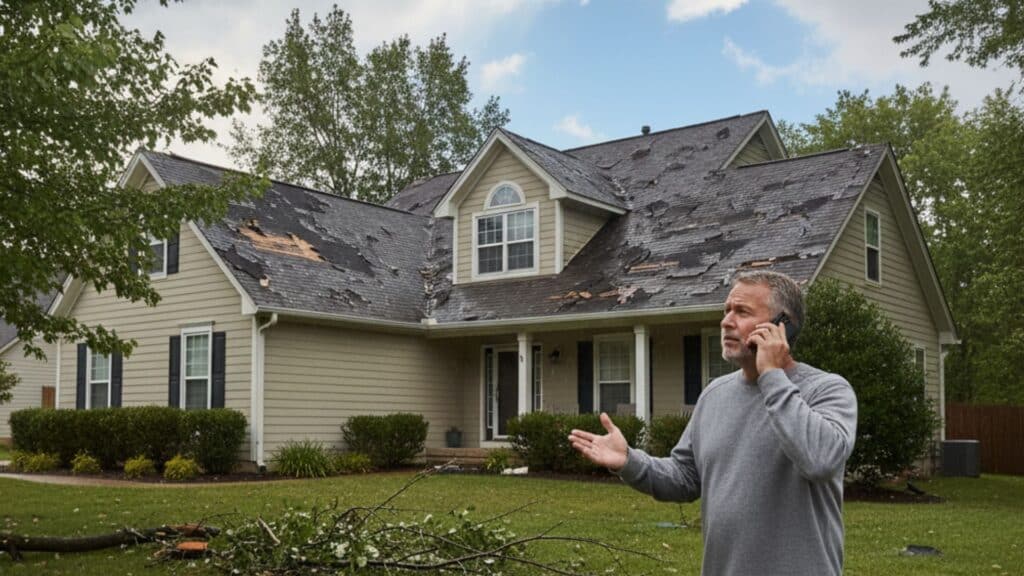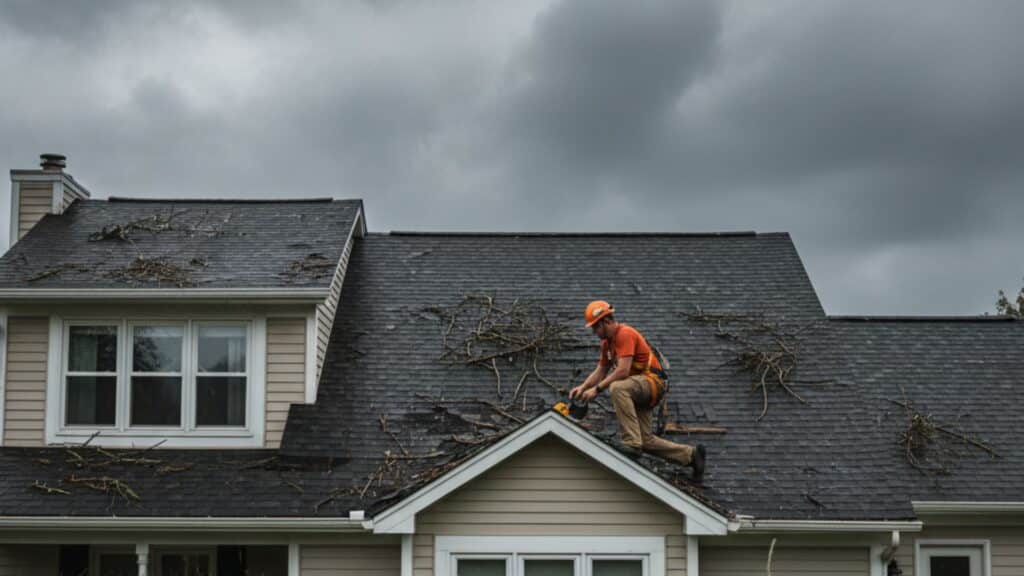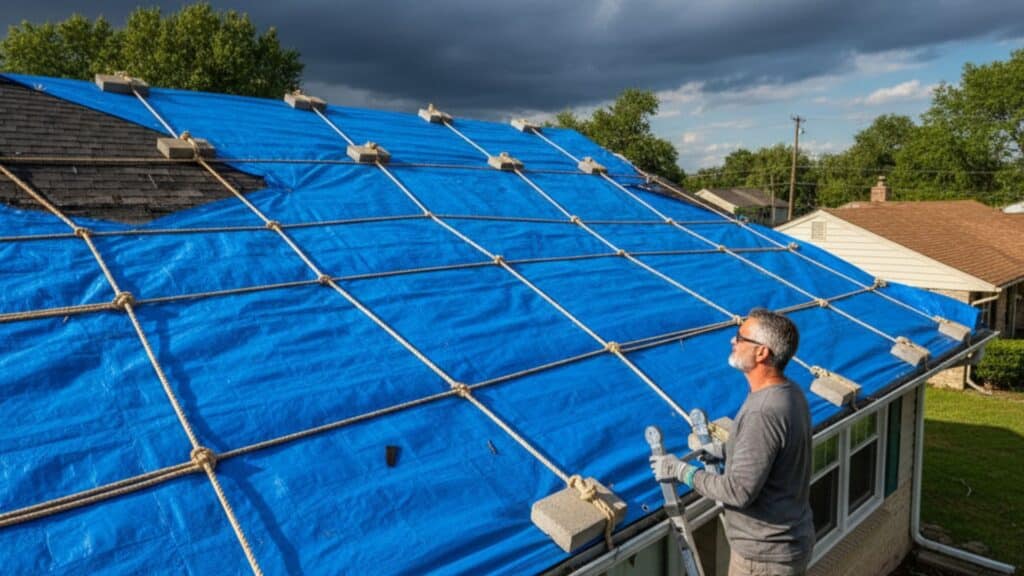Did that last storm leave you staring at your roof, thinking if you need professional help? I know that sinking feeling when you suspect roof storm damage but aren’t sure how to handle it safely.
Storm damage can be tricky because some problems hide while others appear immediately after bad weather hits.
You might need to navigate insurance claims, temporary repairs, and decisions about professional contractors without making costly mistakes.
Getting the right information helps you protect your property and make smart financial choices during stressful situations.
Let me guide you through everything you need to know about identifying, documenting, and properly handling roof storm damage.
What Roof Storm Damage Really Looks Like?
Roof storm damage isn’t always easy to spot, but it can lead to big problems if ignored. After a strong storm, your roof may show signs such as missing or lifted shingles, cracks, dents, or loose flashing.
Hail can leave small, round marks, while wind may tear off shingles or blow debris onto the roof. Even if the damage looks small, water can still get through and cause leaks inside your home.
Sometimes, damage hides under the surface. You might not see it right away, but moisture can build up and weaken the structure over time. That’s why it’s important to check your roof after heavy rain, strong wind, or hail.
Look for signs such as granules from shingles in your gutters, dark spots on the ceiling, or damp insulation in the attic.
Early checks help prevent bigger problems later.
Common Homeowner Experiences After a Storm

After a storm, many homeowners feel stressed and unsure what to do about roof damage. They often notice missing shingles or leaks and worry about costly repairs.
Most start by inspecting the roof carefully and calling a local roofer to check for damage. Then, they contact their insurance company to file a claim.
They learn quickly that acting fast, like covering holes with a tarp, helps stop further damage. Some realize older roofs make claims harder because damage can be harder to spot.
Real stories from a Reddit discussion show how important patience and knowledge are during this process.
How to Evaluate Roof Damage from Storm Safely?

I’ve learned that proper roof damage assessment requires a systematic approach that prioritizes your safety above all else. Here are the safest methods to check your roof after storm damage:
First Visual Check from the Ground
Start by walking around your house and looking at your roof from the ground. Look for missing or loose shingles, dents, or bends in metal roofing. Also check for branches, debris, or granules from shingles on the ground.
A study by the National Institutes of Health shows that ground inspections effectively detect around 80% of roof damage cases.
Use binoculars if needed for a better view. Avoid climbing the roof without training to prevent injury. Take photos of any damage for insurance and repair purposes.
Inspecting the Attic and Ceilings for Leaks
Check your attic and ceilings for signs of leaks after a storm. Look for water stains or dark patches on wooden beams and drywall. Feel the insulation with your hands to see if it’s damp or squishy.
Smell for musty odors, as mold grows with moisture. Approximately 60% of hidden roof damage typically appears first in the attic.
If you find any signs, call a professional promptly to prevent mold and rot from spreading. Early detection can save money and prevent more home damage.
Call professionals after severe storms or when damage is found. Licensed roofers detect 30% more hidden damage than DIY checks using specialized equipment.
Step-by-Step Process for Filing Roof Insurance Claims
Storm damage to your roof requires immediate attention to prevent further costly repairs to your home. Following the right steps in order makes the process smoother and increases your chances of a successful claim:
- Step 1 (Assess Roof Damage): Safely inspect for damage and take clear photos as proof for your claim.
- Step 2 (Contact Your Insurer): Call your insurance company quickly, provide damage details, policy number, and photos.
- Step 3 (Hire a Roofing Contractor): Get a professional inspection and report that supports your claim.
- Step 4 (Meet the Adjuster): Be present during their visit to point out the damage and share the contractor’s findings.
- Step 5 (Review the Adjuster’s Report): Carefully check the report for accuracy. If you find mistakes, contact your insurer to discuss.
Acting quickly while staying organized helps protect your interests throughout the claims process. Keep detailed records of all communications and expenses related to your storm damage for the best results.
If the adjuster’s estimate seems too low, don’t accept it immediately. Request a detailed breakdown, get a second opinion from another contractor, and negotiate with supporting documentation before settling your claim.
Temporary DIY Fixes While Waiting for Repairs

Before scheduling a repair service, there are several DIY solutions you can tackle to stop the damage and potentially save on repair costs. Here’s what you can do yourself:
- Cover exposed areas with a tarp: Grab a heavy-duty tarp from your local hardware store and secure it over the leak with ropes or bungee cords.
- Seal minor cracks and gaps: Pick up some waterproof silicone caulk and apply it to small leaks or cracks. Just clean and dry the area first for better adhesion.
- Reattach loose shingles: If you spot loose or lifted shingles, you can carefully nail them back down or use roofing adhesive.
- Inspect from a safe position: Use a sturdy ladder with rubber feet, wear slip-resistant shoes, and keep three points of contact while climbing.
Many homeowners successfully handle minor roof issues with basic tools and materials. Don’t DIY if you notice sagging spots, steep slopes, or wet surfaces—call the pros instead. Before storm season, keep a checklist ready: tarps, roofing caulk, heavy-duty gloves, flashlight, ladder stabilizer, and a first-aid kit for safety.
Professional Repair vs. Full Roof Replacement
Deciding between repairs and full replacement depends on several key factors that affect both cost and long-term value. Here’s how the two options compare across important decision-making criteria:
| Aspect | Professional Repair | Full Roof Replacement |
|---|---|---|
| Damage Signs | Few missing shingles, small leaks, minor granule loss | Multiple leaks, sagging areas, widespread shingle damage |
| Roof Age | Newer roofs under 15 years | Roofs over 15 years with previous repairs |
| Cost Range | $250-$10,000 | $15,000-$30,000 |
| Timeline | 1-3 days | 1-2 weeks |
The right choice depends on your specific situation, budget, and long-term plans for your home. A professional assessment helps determine which option provides the best value and protection for your particular circumstances.
Warranties, local building codes, and HOA rules can dictate whether a roof may be patched or must be replaced, and repeated small repairs may even void some manufacturer warranties , a critical detail homeowners often overlook when planning maintenance.
Preventing Future Roof Storm Damage
Taking simple steps now saves you time and money later. Here are some proven ways to protect your roof before storm season:
- Schedule roof inspections twice a year and after storms to catch issues early and maintain roof strength.
- Use impact-resistant roofing materials like Class F asphalt shingles or metal roofing designed for high winds and hail.
- Install hurricane straps or clips to secure your roof structure to the house frame, reducing the risk of roof uplift.
- Keep gutters clean and add gutter guards to prevent clogs and water backup that damages roofs during storms.
Following these tips can greatly reduce damage risk and extend your roof’s life. Staying proactive goes a long way in storm preparedness.
Wrapping It Up
Roof storm damage doesn’t have to become a nightmare when you know the right steps to take. I hope this information gives you confidence to handle storm damage safely while protecting your home and wallet.
Remember that acting quickly prevents small problems from becoming expensive disasters that affect your entire house.
Professional help is always worth the cost when you’re dealing with significant damage or safety concerns. Your roof protects everything you value, so treating storm damage seriously makes perfect financial and safety sense.
Prevention and proper maintenance go a long way toward reducing future storm damage to your property. Ready to tackle your next storm season with confidence? Drop a comment below about your biggest roof concern!














